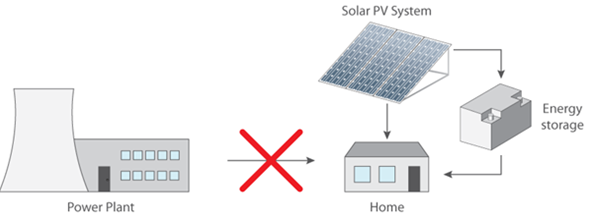Although we’re still waiting for it to happen, everyone in the Australian renewable energy sector is talking (a lot) about energy storage and its supposedly massive potential to revolutionise how electricity is generated & distributed in the country. When most of us think about energy storage, what we envision is a solar system with a battery bank that enables a home or business owner to produce their own power and the ability to store it for later use.
This is indeed one of the markets that will undoubtedly grow—especially with battery costs coming down and a large number of disgruntled power bill payers—but the electricity powers-that-be may get in on the action as well. Australia-based Global Sustainable Energy Solutions (GSES) recently broke down the market possibilities for energy storage into understandable chunks at the APVI’s energy storage workshop at the International Battery Association Conference and published an article on the topic on the WattClarity website. The options, they say, are 3-fold: Private ownership, utility ownership and gentailer/retailer ownership. (I would offer up a 4th possibility not included above: 3rd party-owned systems for homes and businesses financed through a solar lease-type arrangements.)
Private ownership energy storage market
Private distributed energy storage systems, coupled with solar PV, will allow homes & businesses to reduce their reliance on the grid for their electricity–in some cases even allowing for 100% electricity independence. With more and more Australians upset about high power bills, it makes sense that many will look for ways to get as ‘off grid’ as their funds will allow.
Of course, energy storage costs, while falling, are not where they need to be to make sense like rooftop solar PV does in most parts of Australia. Those who choose the private option will have to shoulder the costs of a system–plus do ongoing maintenance and deal with possible equipment failures–themselves.
Image via GSES
Utilities use energy storage systems as infrastructure
GSES suggests that utilities could get involved in the energy storage market themselves by incorporating battery banks into existing electricity infrastructure. A utility’s role, after all, is to provide access to electricity–batteries could just be another way that they provide this service to their customers. Batteries could be operated directly by utilities and possibly even be located on the ‘street level’ to be switched on and off as necessary to meet regional and temporal fluctuations in demand.
GSES notes, however, that given the newness of the concept, how these street-level battery banks would be integrated into the wholesale electricity market is a big question. Another way they could approach the issue could be to lease energy storage units to the homes they deliver power to in an arrangement similar to a solar leasing program. This would allow the customers the option of drawing power from the grid or from their battery bank at differing rates, allowing them to save money by being strategic about how and when they consume electricity.
Image via GSES (Click to enlarge)
Electricity retailers/gentailers provide energy storage to customers
Energy retailers purchase electricity from the wholesale energy market on behalf of their customers; ‘Generator-Retailers’ (‘gentailers’) do the same but they also produce some of the power. In addition to the wholesale costs of the power they purchase or generate, they must also pay network fees–and along the way of course also add their own markup. GSES suggests retailers/gentailers could get in on the energy storage game by offering to lease systems (with or without solar PV) to their customers–building distributed generation capacity instead of centralised plants.
In doing so, they would be able to count on these distributed systems as a potentially cheaper alternative to their other purchase or generation options–especially handy during peak demand time. They would be able to meet customer electricity demand through some combination of solar PV, energy storage and the wholesale market. The retailers/gentailers would be responsible for all maintenance and upkeep of the systems, so customers would take on none of the risk associated with purchasing a system.
GSES says this approach could fit easily into the existing gentailer business model: “In many ways, distributed storage can be thought of in the same way as a peaking generator. When a retailer acquires a new customer, instead of ensuring they have enough generation or futures contracts to cover the new demand, they will also have the option to install a storage system (either with or without PV). Gentailers could install and operate battery systems to reduce a customers’ supply cost.”
Image via GSES
© 2014 Solar Choice Pty Ltd


